Financial Performance Analysis: British Airways and American Airlines
VerifiedAdded on 2020/10/22
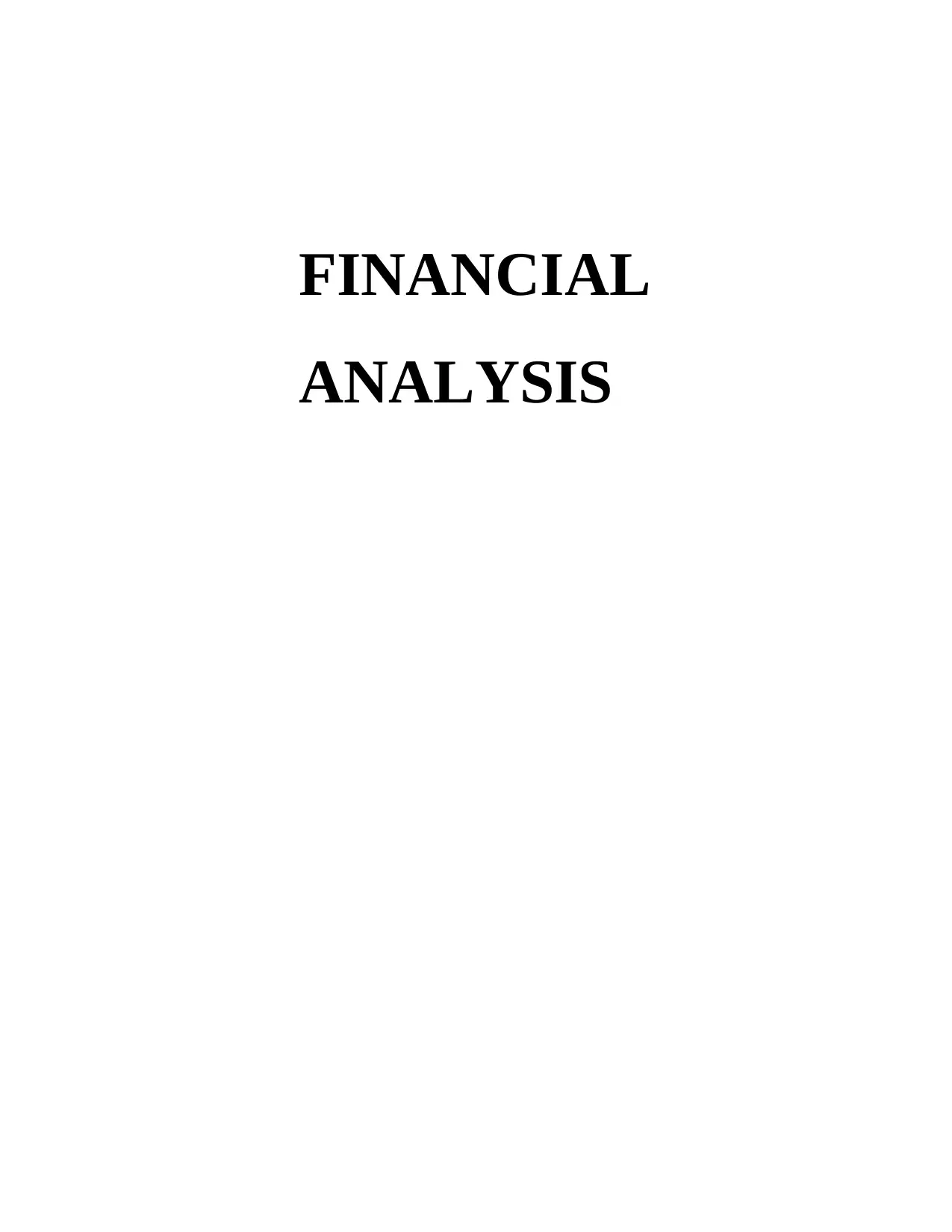
ANALYSIS
Paraphrase This Document
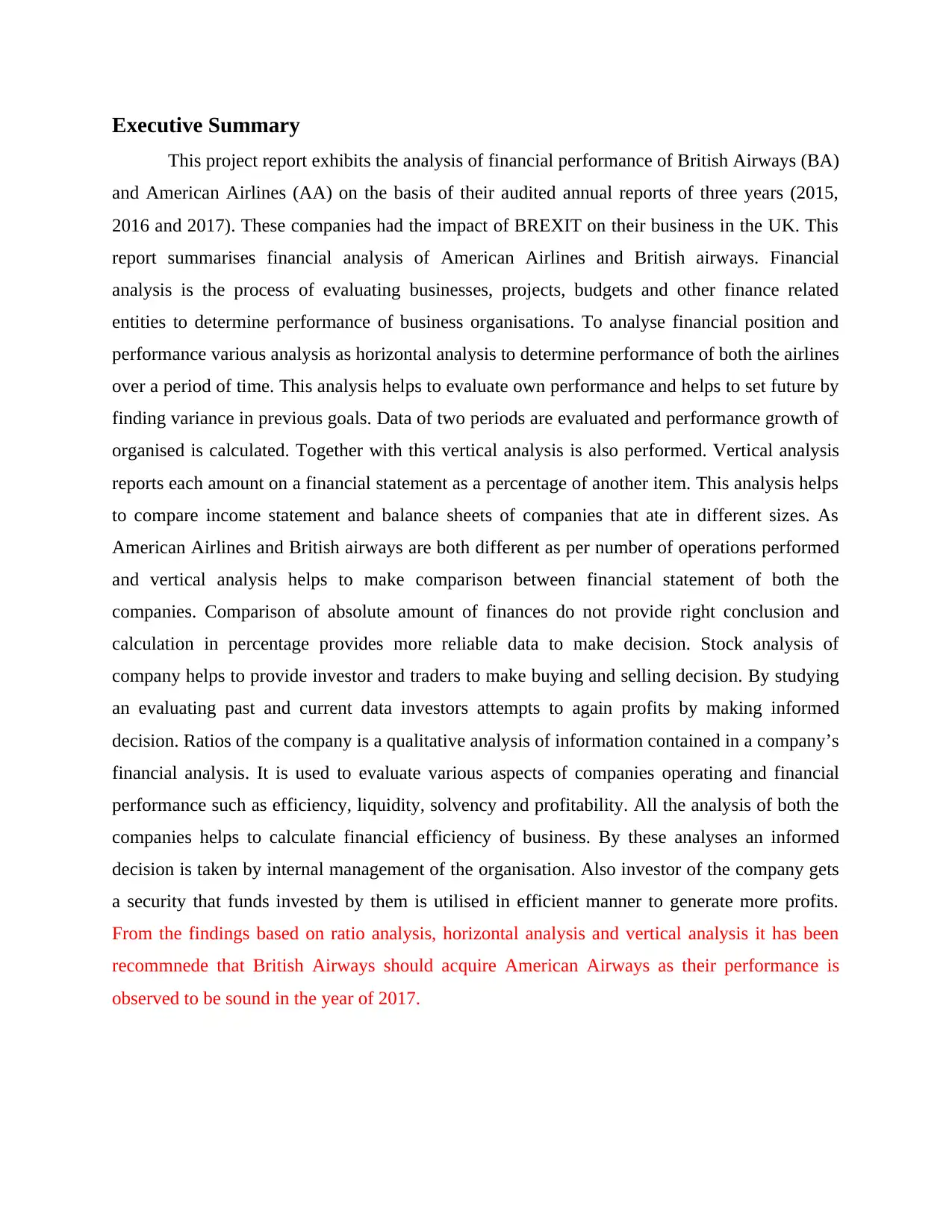
This project report exhibits the analysis of financial performance of British Airways (BA)
and American Airlines (AA) on the basis of their audited annual reports of three years (2015,
2016 and 2017). These companies had the impact of BREXIT on their business in the UK. This
report summarises financial analysis of American Airlines and British airways. Financial
analysis is the process of evaluating businesses, projects, budgets and other finance related
entities to determine performance of business organisations. To analyse financial position and
performance various analysis as horizontal analysis to determine performance of both the airlines
over a period of time. This analysis helps to evaluate own performance and helps to set future by
finding variance in previous goals. Data of two periods are evaluated and performance growth of
organised is calculated. Together with this vertical analysis is also performed. Vertical analysis
reports each amount on a financial statement as a percentage of another item. This analysis helps
to compare income statement and balance sheets of companies that ate in different sizes. As
American Airlines and British airways are both different as per number of operations performed
and vertical analysis helps to make comparison between financial statement of both the
companies. Comparison of absolute amount of finances do not provide right conclusion and
calculation in percentage provides more reliable data to make decision. Stock analysis of
company helps to provide investor and traders to make buying and selling decision. By studying
an evaluating past and current data investors attempts to again profits by making informed
decision. Ratios of the company is a qualitative analysis of information contained in a company’s
financial analysis. It is used to evaluate various aspects of companies operating and financial
performance such as efficiency, liquidity, solvency and profitability. All the analysis of both the
companies helps to calculate financial efficiency of business. By these analyses an informed
decision is taken by internal management of the organisation. Also investor of the company gets
a security that funds invested by them is utilised in efficient manner to generate more profits.
From the findings based on ratio analysis, horizontal analysis and vertical analysis it has been
recommnede that British Airways should acquire American Airways as their performance is
observed to be sound in the year of 2017.
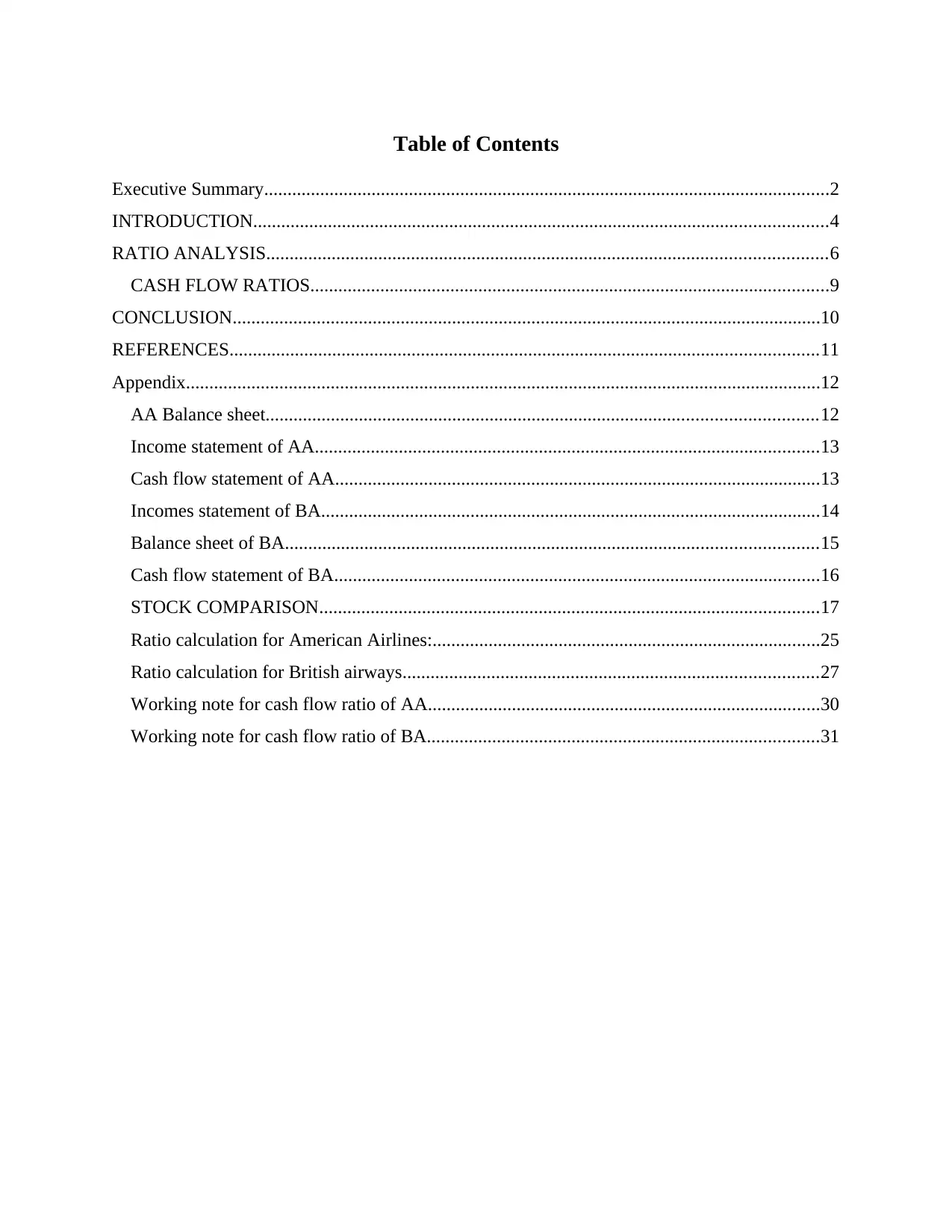
Executive Summary.........................................................................................................................2
INTRODUCTION...........................................................................................................................4
RATIO ANALYSIS........................................................................................................................6
CASH FLOW RATIOS...............................................................................................................9
CONCLUSION..............................................................................................................................10
REFERENCES..............................................................................................................................11
Appendix........................................................................................................................................12
AA Balance sheet......................................................................................................................12
Income statement of AA............................................................................................................13
Cash flow statement of AA........................................................................................................13
Incomes statement of BA...........................................................................................................14
Balance sheet of BA..................................................................................................................15
Cash flow statement of BA........................................................................................................16
STOCK COMPARISON...........................................................................................................17
Ratio calculation for American Airlines:...................................................................................25
Ratio calculation for British airways.........................................................................................27
Working note for cash flow ratio of AA....................................................................................30
Working note for cash flow ratio of BA....................................................................................31
⊘ This is a preview!⊘
Do you want full access?
Subscribe today to unlock all pages.

Trusted by 1+ million students worldwide
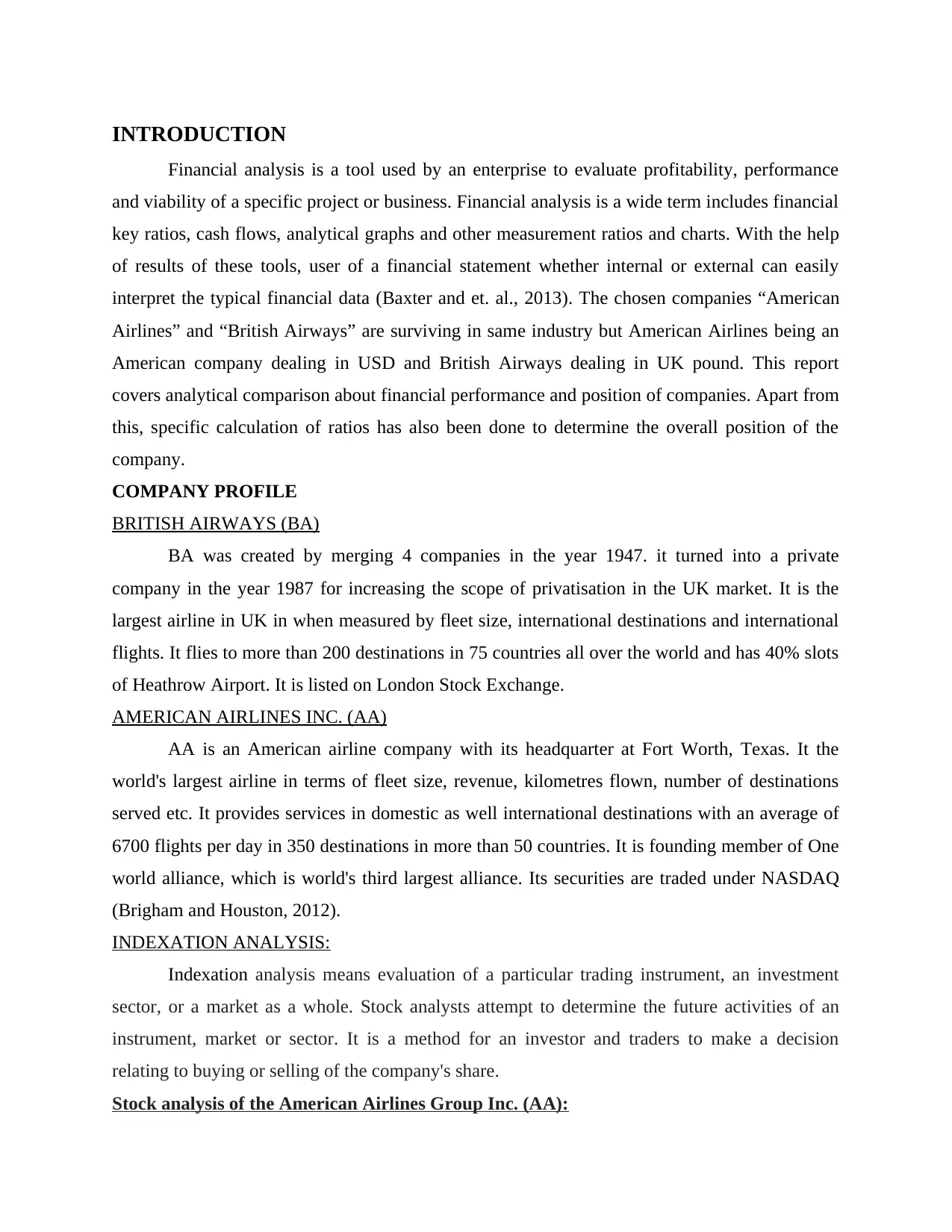
Financial analysis is a tool used by an enterprise to evaluate profitability, performance
and viability of a specific project or business. Financial analysis is a wide term includes financial
key ratios, cash flows, analytical graphs and other measurement ratios and charts. With the help
of results of these tools, user of a financial statement whether internal or external can easily
interpret the typical financial data (Baxter and et. al., 2013). The chosen companies “American
Airlines” and “British Airways” are surviving in same industry but American Airlines being an
American company dealing in USD and British Airways dealing in UK pound. This report
covers analytical comparison about financial performance and position of companies. Apart from
this, specific calculation of ratios has also been done to determine the overall position of the
company.
COMPANY PROFILE
BRITISH AIRWAYS (BA)
BA was created by merging 4 companies in the year 1947. it turned into a private
company in the year 1987 for increasing the scope of privatisation in the UK market. It is the
largest airline in UK in when measured by fleet size, international destinations and international
flights. It flies to more than 200 destinations in 75 countries all over the world and has 40% slots
of Heathrow Airport. It is listed on London Stock Exchange.
AMERICAN AIRLINES INC. (AA)
AA is an American airline company with its headquarter at Fort Worth, Texas. It the
world's largest airline in terms of fleet size, revenue, kilometres flown, number of destinations
served etc. It provides services in domestic as well international destinations with an average of
6700 flights per day in 350 destinations in more than 50 countries. It is founding member of One
world alliance, which is world's third largest alliance. Its securities are traded under NASDAQ
(Brigham and Houston, 2012).
INDEXATION ANALYSIS:
Indexation analysis means evaluation of a particular trading instrument, an investment
sector, or a market as a whole. Stock analysts attempt to determine the future activities of an
instrument, market or sector. It is a method for an investor and traders to make a decision
relating to buying or selling of the company's share.
Stock analysis of the American Airlines Group Inc. (AA):
Paraphrase This Document

1000. Day's Range is $ 29.78 to $ 32.21.
The average price of AAL as per historical data is (40.48 + 44.74 + 36.30 + 38.98 +
38.88) / 5 = $ 41.48 and current price is $ 32.04, current price is lower than the price as per the
historical data, therefore an investor will love to invest in the shares of AAL because current
price is undervalued.
It has a market cap of $ 14.757B and profit earnings ratio of 13.14 and EPS is 2.44 with
current average volume of 9,692,020. The shares are less costly as compare of British Airways
and have better chances of earning as an investor point of view.
Stock analysis of British airways (BA):
In the British airways, there is rise in opening price of stock as compared to previous
closing price. The opening stock price is 346.51 and bid rate is 351.21*800, ask rate is
351.95*800, day's range is 343.00 to 353.47.
The British airways have a share price as per historical share price is £196.58 whereas current
market price is £ 352.61 so it is concluded that present price of the British Airways is higher than
the historical price which means it is presently overvalued. Therefore, investor will never invest
in the shares of British airways and it is costly than the shares of AAL of American airways.
Therefore, investor will always invest in AAL as compare to British airways (Bromiley and et.
al., 2015).
NOTE: Tables are shown in the appendix.
VERTICAL ANALYSIS
This method is used by the companies in financial statement analysis, in which each item
is expressed as a percentage of the base figure. It is used for a single point of time to see the
increase or decrease in the accounts during that period for conducting a comparison of financial
position of two companies (Dunning and Dunning, 2014).
Balance sheet comparison
In terms of Total Asset (TA) of British Airways (BA) is comparatively better than
American Airline Inc. (AA) as the TA of AA in 2016 increased to 20.13% from 20.26% in 2015
and it has reduced to 17.80% in the 2017. Whereas, the change in the total asset of BA is
increasing every year. This comparison shows the BA has more total assets than AA. Further, the
percentage change in current liabilities of BA has been decreasing every year which shows that it
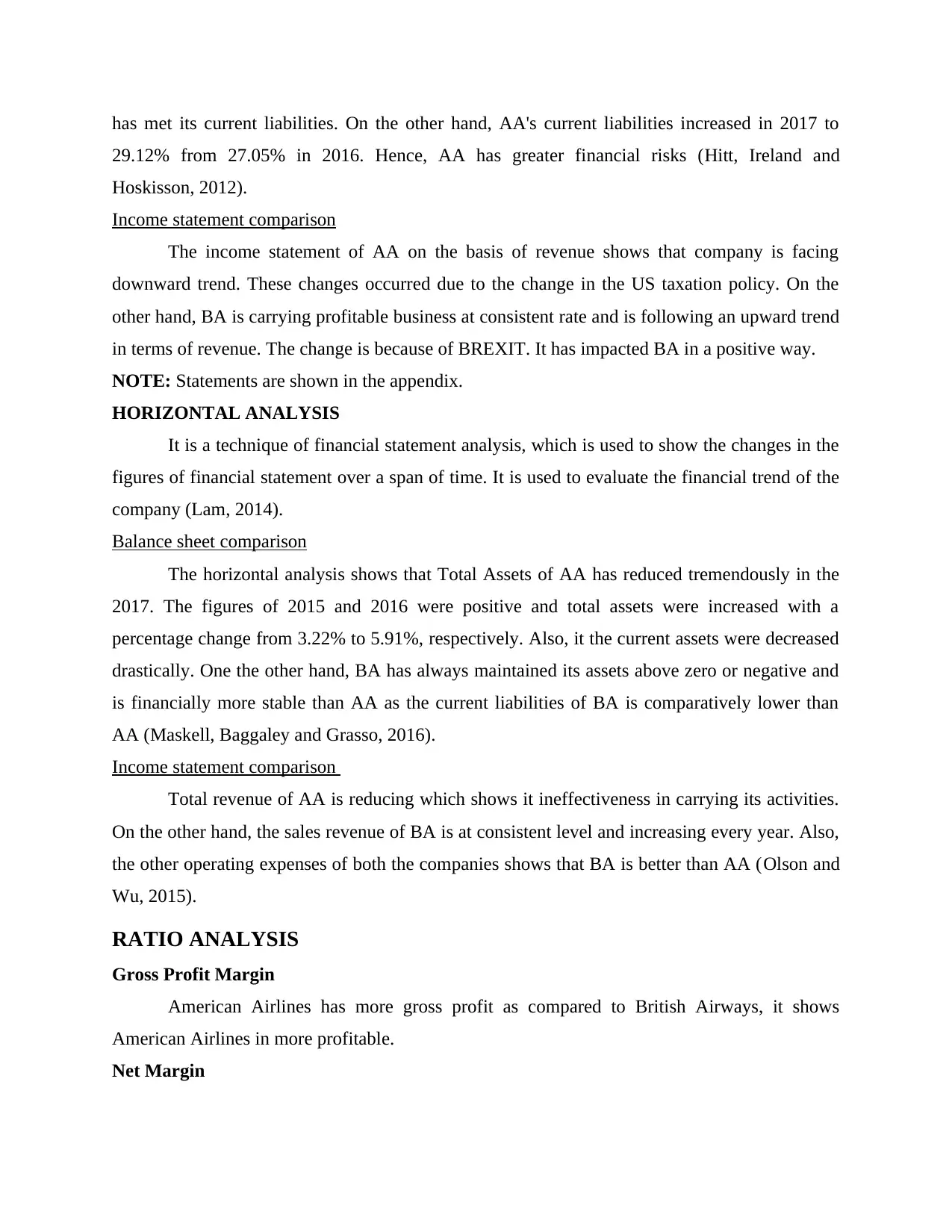
29.12% from 27.05% in 2016. Hence, AA has greater financial risks (Hitt, Ireland and
Hoskisson, 2012).
Income statement comparison
The income statement of AA on the basis of revenue shows that company is facing
downward trend. These changes occurred due to the change in the US taxation policy. On the
other hand, BA is carrying profitable business at consistent rate and is following an upward trend
in terms of revenue. The change is because of BREXIT. It has impacted BA in a positive way.
NOTE: Statements are shown in the appendix.
HORIZONTAL ANALYSIS
It is a technique of financial statement analysis, which is used to show the changes in the
figures of financial statement over a span of time. It is used to evaluate the financial trend of the
company (Lam, 2014).
Balance sheet comparison
The horizontal analysis shows that Total Assets of AA has reduced tremendously in the
2017. The figures of 2015 and 2016 were positive and total assets were increased with a
percentage change from 3.22% to 5.91%, respectively. Also, it the current assets were decreased
drastically. One the other hand, BA has always maintained its assets above zero or negative and
is financially more stable than AA as the current liabilities of BA is comparatively lower than
AA (Maskell, Baggaley and Grasso, 2016).
Income statement comparison
Total revenue of AA is reducing which shows it ineffectiveness in carrying its activities.
On the other hand, the sales revenue of BA is at consistent level and increasing every year. Also,
the other operating expenses of both the companies shows that BA is better than AA (Olson and
Wu, 2015).
RATIO ANALYSIS
Gross Profit Margin
American Airlines has more gross profit as compared to British Airways, it shows
American Airlines in more profitable.
Net Margin
⊘ This is a preview!⊘
Do you want full access?
Subscribe today to unlock all pages.

Trusted by 1+ million students worldwide
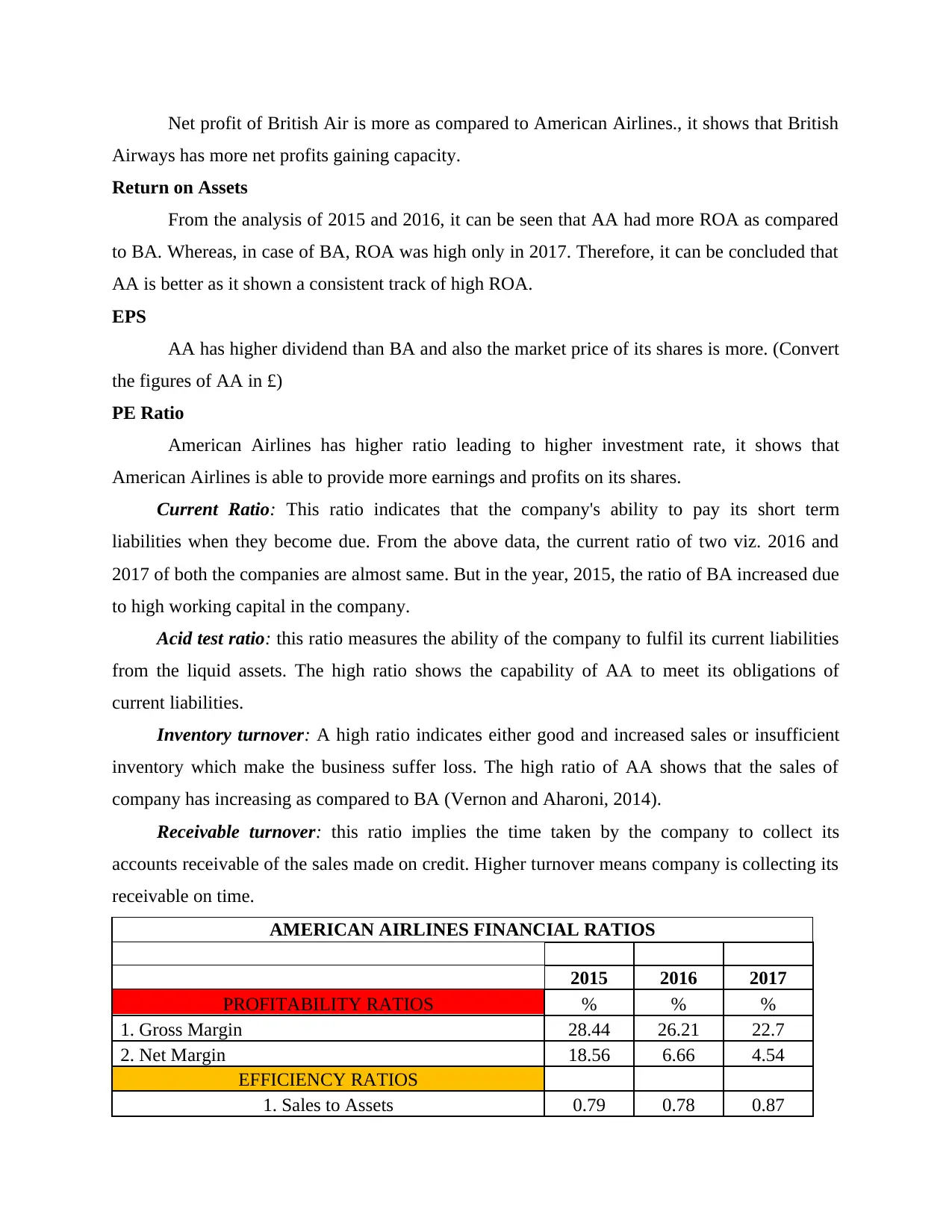
Airways has more net profits gaining capacity.
Return on Assets
From the analysis of 2015 and 2016, it can be seen that AA had more ROA as compared
to BA. Whereas, in case of BA, ROA was high only in 2017. Therefore, it can be concluded that
AA is better as it shown a consistent track of high ROA.
EPS
AA has higher dividend than BA and also the market price of its shares is more. (Convert
the figures of AA in £)
PE Ratio
American Airlines has higher ratio leading to higher investment rate, it shows that
American Airlines is able to provide more earnings and profits on its shares.
Current Ratio: This ratio indicates that the company's ability to pay its short term
liabilities when they become due. From the above data, the current ratio of two viz. 2016 and
2017 of both the companies are almost same. But in the year, 2015, the ratio of BA increased due
to high working capital in the company.
Acid test ratio: this ratio measures the ability of the company to fulfil its current liabilities
from the liquid assets. The high ratio shows the capability of AA to meet its obligations of
current liabilities.
Inventory turnover: A high ratio indicates either good and increased sales or insufficient
inventory which make the business suffer loss. The high ratio of AA shows that the sales of
company has increasing as compared to BA (Vernon and Aharoni, 2014).
Receivable turnover: this ratio implies the time taken by the company to collect its
accounts receivable of the sales made on credit. Higher turnover means company is collecting its
receivable on time.
AMERICAN AIRLINES FINANCIAL RATIOS
2015 2016 2017
PROFITABILITY RATIOS % % %
1. Gross Margin 28.44 26.21 22.7
2. Net Margin 18.56 6.66 4.54
EFFICIENCY RATIOS
1. Sales to Assets 0.79 0.78 0.87
Paraphrase This Document

LIQUIDITY RATIOS
1. Current Ratio 0.733 0.74 0.611
2.Acid Test RATIO 0.61 0.62 0.47
GEARING RATIOS
1.Gearing Ratio’s 5.859 13.54 13.09
2.interest Cover Ratio 5.24 4.33 2.98
INVESTORS RATIOS
1. Dividend -Pay Out Ratio 0.036 0.083 0.103
2.Price earnings ratio P/E 0.514 1.80 2.12
BRITISH AIRWAYS FINANTIAL RATIOS
2015 2016 2017
PROFITABILITY RATIOS % % %
1. Gross Margin 7.14% 8.06% 9.09%
2. Net Margin 22.13% 12.01% 11.84%
EFFICIENCY RATIOS
1. Sales to Assets 0.74 0.69 0.73
2. Return on Investment 7.69% 8.77% 10.00%
LIQUIDITY RATIOS
1. Current Ratio 0.6 0.76 0.83
2.Acid Test RATIO 0.57 0.74 0.8
GEARING RATIOS
1.Gearing Ratio 2.34 2.88 1.79
2.interest Cover Ratio 8.43 9.74 15.85
INVESTORS RATIOS
1. Dividend -Pay Out Ratio 0.1 0.26 0.32
2.Price earnings ratio P/E 6.05 5.12 13.14
Interpretation:
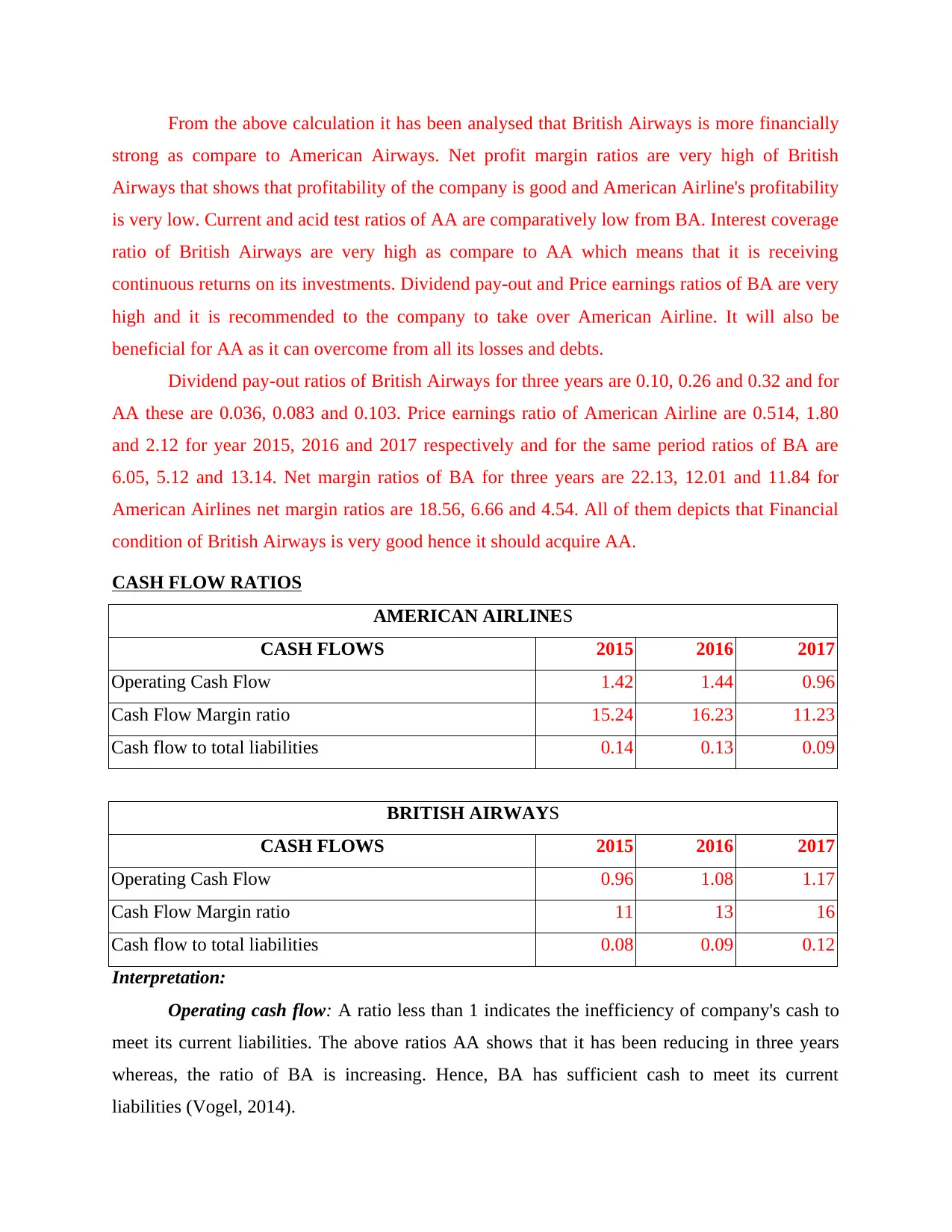
strong as compare to American Airways. Net profit margin ratios are very high of British
Airways that shows that profitability of the company is good and American Airline's profitability
is very low. Current and acid test ratios of AA are comparatively low from BA. Interest coverage
ratio of British Airways are very high as compare to AA which means that it is receiving
continuous returns on its investments. Dividend pay-out and Price earnings ratios of BA are very
high and it is recommended to the company to take over American Airline. It will also be
beneficial for AA as it can overcome from all its losses and debts.
Dividend pay-out ratios of British Airways for three years are 0.10, 0.26 and 0.32 and for
AA these are 0.036, 0.083 and 0.103. Price earnings ratio of American Airline are 0.514, 1.80
and 2.12 for year 2015, 2016 and 2017 respectively and for the same period ratios of BA are
6.05, 5.12 and 13.14. Net margin ratios of BA for three years are 22.13, 12.01 and 11.84 for
American Airlines net margin ratios are 18.56, 6.66 and 4.54. All of them depicts that Financial
condition of British Airways is very good hence it should acquire AA.
CASH FLOW RATIOS
AMERICAN AIRLINES
CASH FLOWS 2015 2016 2017
Operating Cash Flow 1.42 1.44 0.96
Cash Flow Margin ratio 15.24 16.23 11.23
Cash flow to total liabilities 0.14 0.13 0.09
BRITISH AIRWAYS
CASH FLOWS 2015 2016 2017
Operating Cash Flow 0.96 1.08 1.17
Cash Flow Margin ratio 11 13 16
Cash flow to total liabilities 0.08 0.09 0.12
Interpretation:
Operating cash flow: A ratio less than 1 indicates the inefficiency of company's cash to
meet its current liabilities. The above ratios AA shows that it has been reducing in three years
whereas, the ratio of BA is increasing. Hence, BA has sufficient cash to meet its current
liabilities (Vogel, 2014).
⊘ This is a preview!⊘
Do you want full access?
Subscribe today to unlock all pages.

Trusted by 1+ million students worldwide
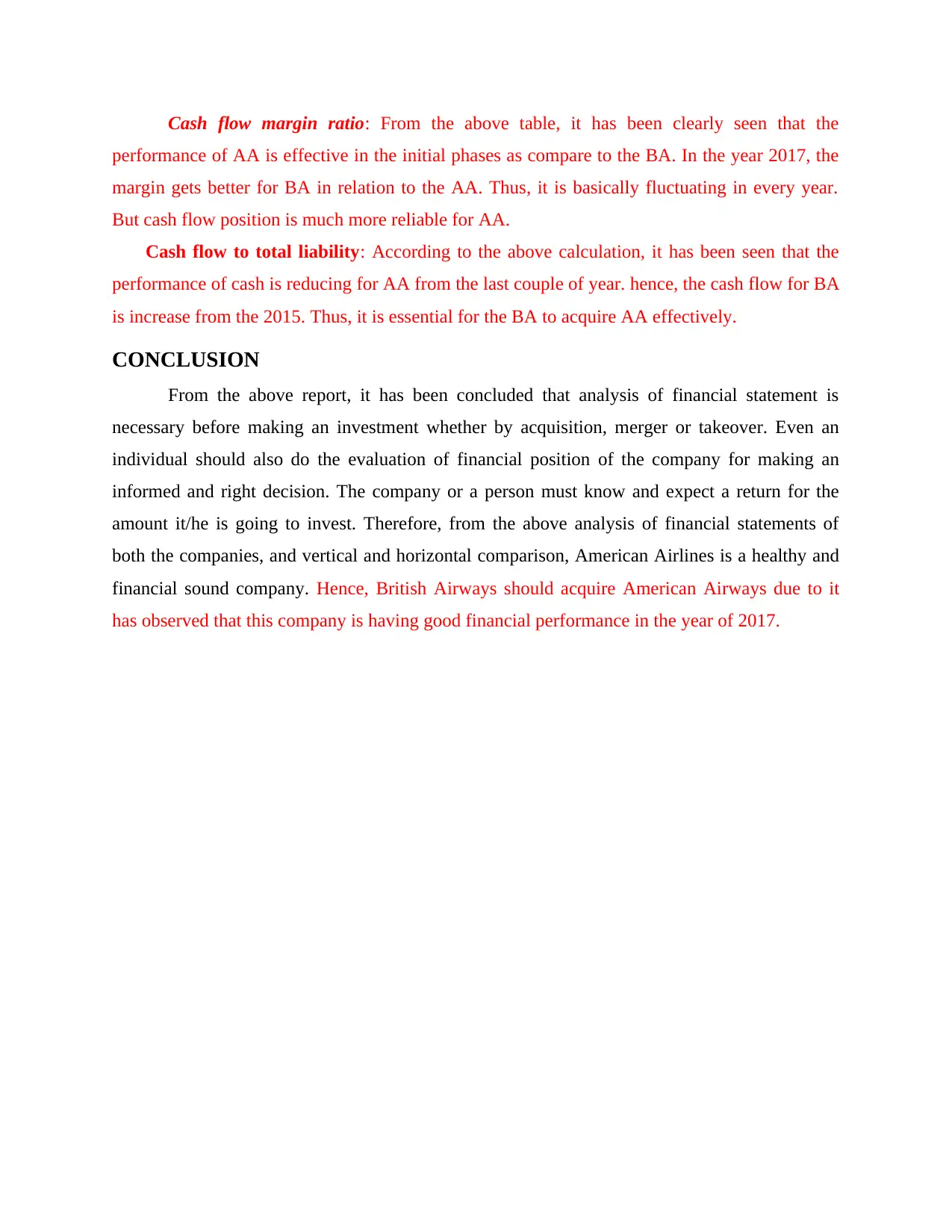
performance of AA is effective in the initial phases as compare to the BA. In the year 2017, the
margin gets better for BA in relation to the AA. Thus, it is basically fluctuating in every year.
But cash flow position is much more reliable for AA.
Cash flow to total liability: According to the above calculation, it has been seen that the
performance of cash is reducing for AA from the last couple of year. hence, the cash flow for BA
is increase from the 2015. Thus, it is essential for the BA to acquire AA effectively.
CONCLUSION
From the above report, it has been concluded that analysis of financial statement is
necessary before making an investment whether by acquisition, merger or takeover. Even an
individual should also do the evaluation of financial position of the company for making an
informed and right decision. The company or a person must know and expect a return for the
amount it/he is going to invest. Therefore, from the above analysis of financial statements of
both the companies, and vertical and horizontal comparison, American Airlines is a healthy and
financial sound company. Hence, British Airways should acquire American Airways due to it
has observed that this company is having good financial performance in the year of 2017.
Paraphrase This Document
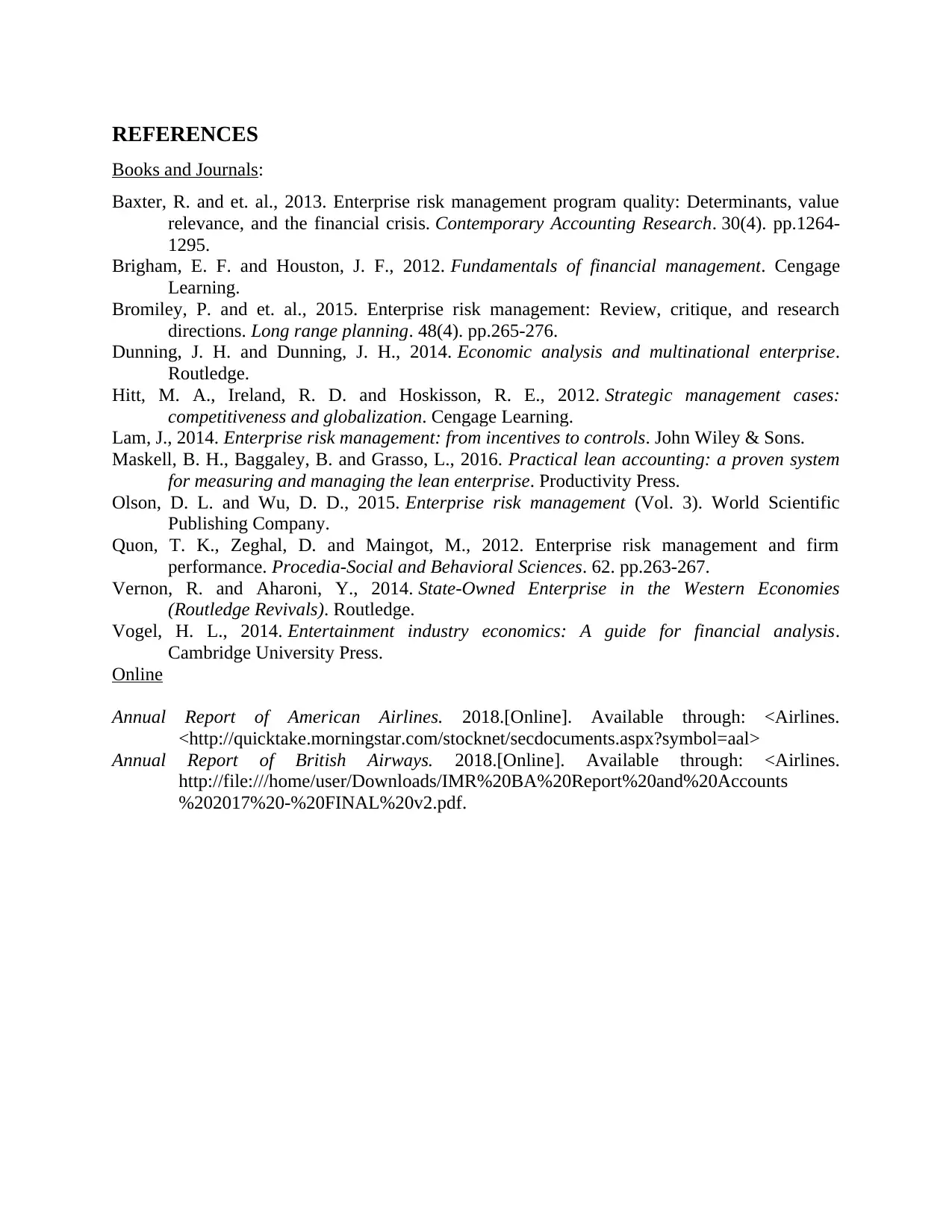
Books and Journals:
Baxter, R. and et. al., 2013. Enterprise risk management program quality: Determinants, value
relevance, and the financial crisis. Contemporary Accounting Research. 30(4). pp.1264-
1295.
Brigham, E. F. and Houston, J. F., 2012. Fundamentals of financial management. Cengage
Learning.
Bromiley, P. and et. al., 2015. Enterprise risk management: Review, critique, and research
directions. Long range planning. 48(4). pp.265-276.
Dunning, J. H. and Dunning, J. H., 2014. Economic analysis and multinational enterprise.
Routledge.
Hitt, M. A., Ireland, R. D. and Hoskisson, R. E., 2012. Strategic management cases:
competitiveness and globalization. Cengage Learning.
Lam, J., 2014. Enterprise risk management: from incentives to controls. John Wiley & Sons.
Maskell, B. H., Baggaley, B. and Grasso, L., 2016. Practical lean accounting: a proven system
for measuring and managing the lean enterprise. Productivity Press.
Olson, D. L. and Wu, D. D., 2015. Enterprise risk management (Vol. 3). World Scientific
Publishing Company.
Quon, T. K., Zeghal, D. and Maingot, M., 2012. Enterprise risk management and firm
performance. Procedia-Social and Behavioral Sciences. 62. pp.263-267.
Vernon, R. and Aharoni, Y., 2014. State-Owned Enterprise in the Western Economies
(Routledge Revivals). Routledge.
Vogel, H. L., 2014. Entertainment industry economics: A guide for financial analysis.
Cambridge University Press.
Online
Annual Report of American Airlines. 2018.[Online]. Available through: <Airlines.
<http://quicktake.morningstar.com/stocknet/secdocuments.aspx?symbol=aal>
Annual Report of British Airways. 2018.[Online]. Available through: <Airlines.
http://file:///home/user/Downloads/IMR%20BA%20Report%20and%20Accounts
%202017%20-%20FINAL%20v2.pdf.
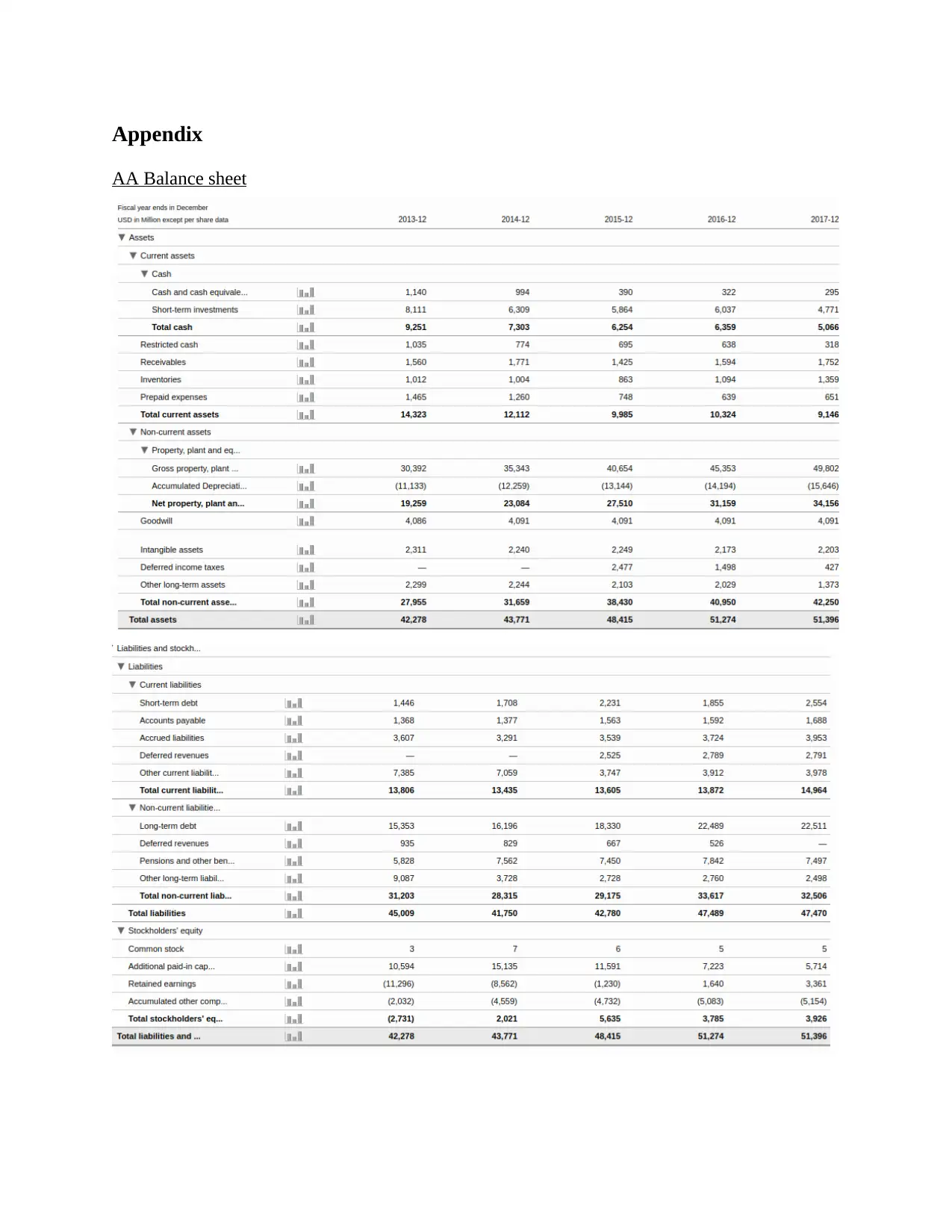
AA Balance sheet
⊘ This is a preview!⊘
Do you want full access?
Subscribe today to unlock all pages.

Trusted by 1+ million students worldwide
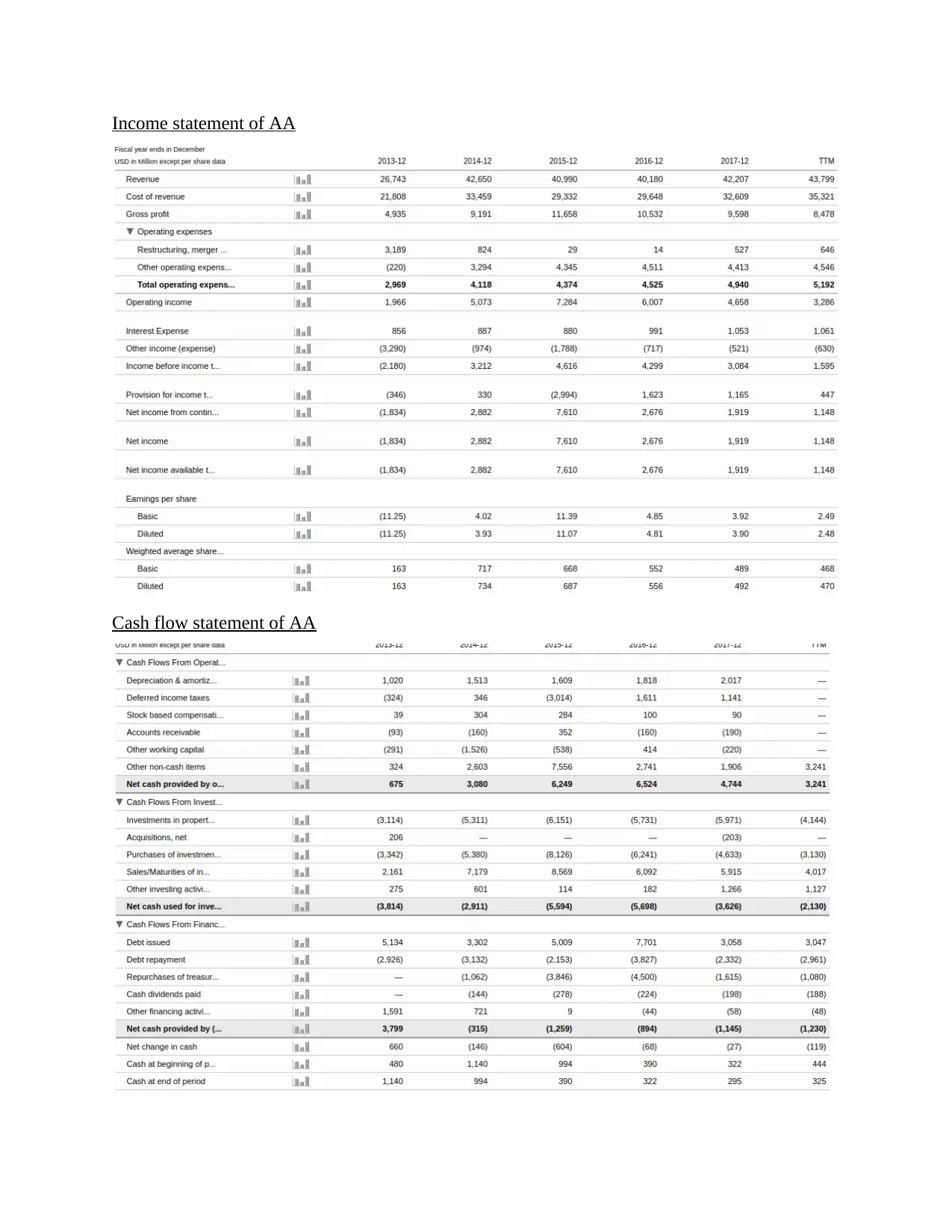
Cash flow statement of AA
Paraphrase This Document
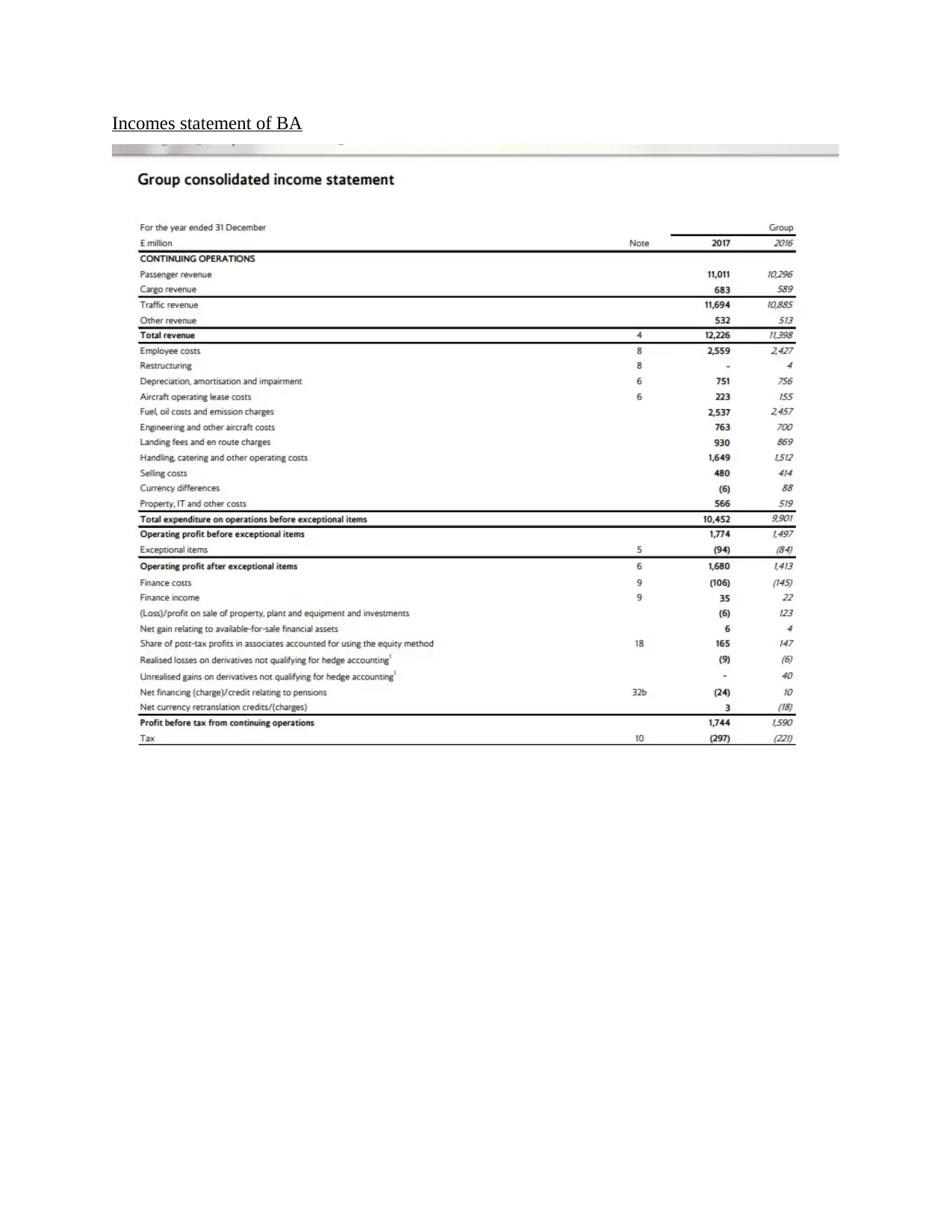

⊘ This is a preview!⊘
Do you want full access?
Subscribe today to unlock all pages.

Trusted by 1+ million students worldwide
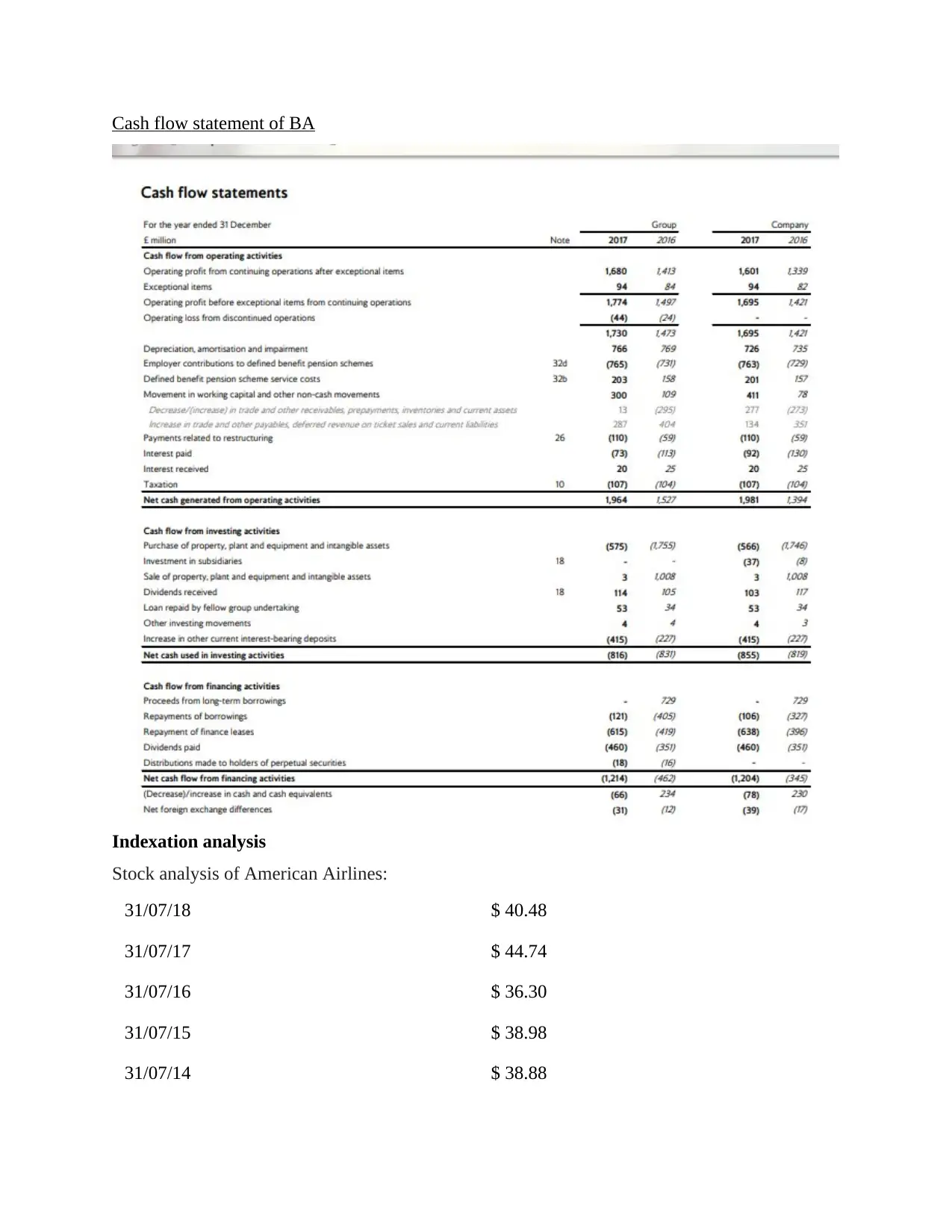
Indexation analysis
Stock analysis of American Airlines:
31/07/18 $ 40.48
31/07/17 $ 44.74
31/07/16 $ 36.30
31/07/15 $ 38.98
31/07/14 $ 38.88
Paraphrase This Document
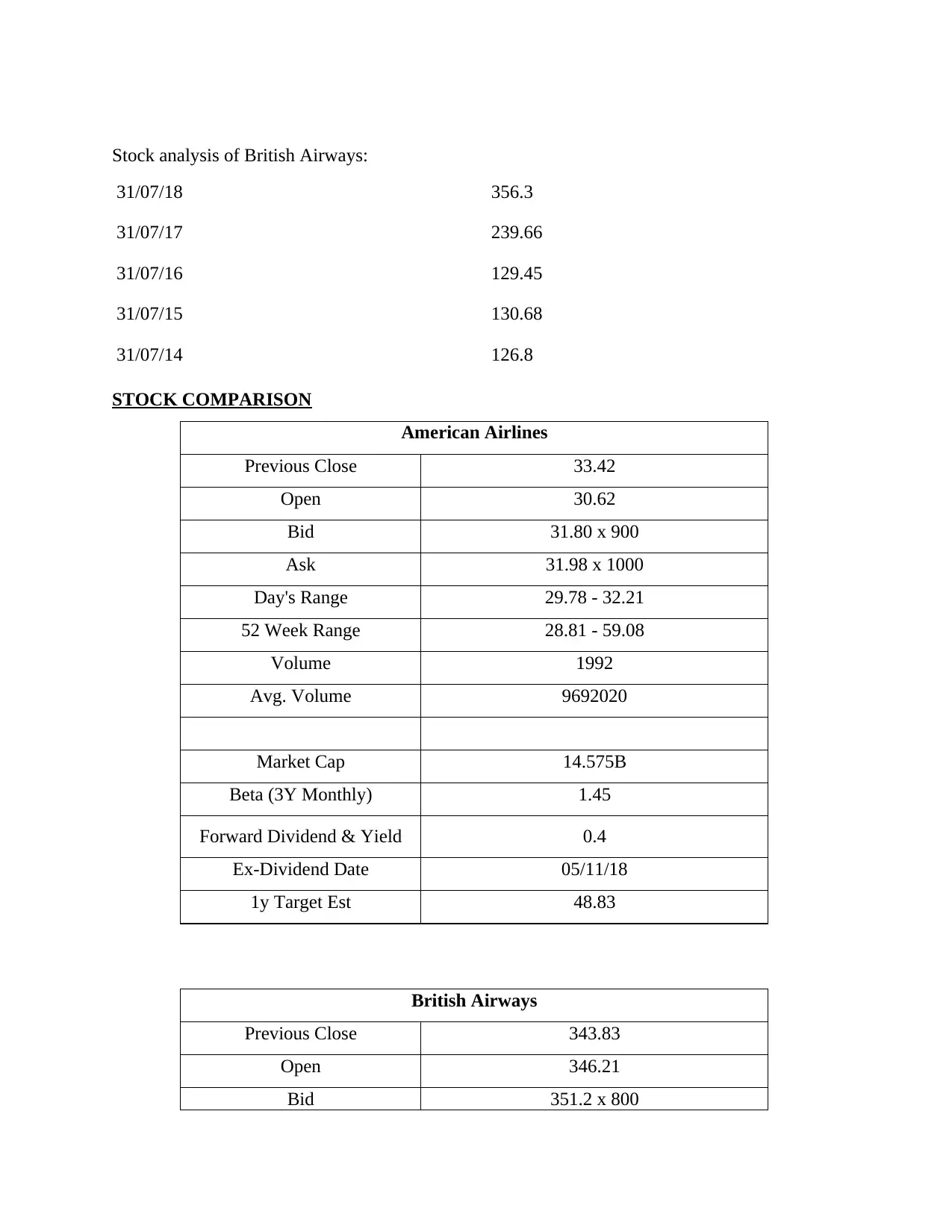
31/07/18 356.3
31/07/17 239.66
31/07/16 129.45
31/07/15 130.68
31/07/14 126.8
STOCK COMPARISON
American Airlines
Previous Close 33.42
Open 30.62
Bid 31.80 x 900
Ask 31.98 x 1000
Day's Range 29.78 - 32.21
52 Week Range 28.81 - 59.08
Volume 1992
Avg. Volume 9692020
Market Cap 14.575B
Beta (3Y Monthly) 1.45
Forward Dividend & Yield 0.4
Ex-Dividend Date 05/11/18
1y Target Est 48.83
British Airways
Previous Close 343.83
Open 346.21
Bid 351.2 x 800

Day's Range 343.00 - 353.47
52 Week Range 292.47 - 394.28
Volume 5358117
Avg. Volume 4373695
Market Cap 200.242B
Beta (3Y Monthly) 1.56
Forward Dividend & Yield 8.22
Ex-Dividend Date 07/02/19
1y Target Est 417.6
VERTICAL ANALYSIS:
Balance Sheet:
Financial Statement
Particulars American Airlines
2015 % 2016 % 2017 %
Current Assets
Cash and cash equivalent 6254 12.92% 6359 12.40% 5066
9.86
%
Receivables 1425 2.94% 1594 3.11% 1752
3.41
%
Inventories 863 1.78% 1094 2.13% 1359
2.64
%
Other Current Assets 1443 2.98% 1277 2.49% 969
1.89
%
Total Current assets 9985 20.62% 10324 20.13% 9146
17.80
%
⊘ This is a preview!⊘
Do you want full access?
Subscribe today to unlock all pages.

Trusted by 1+ million students worldwide
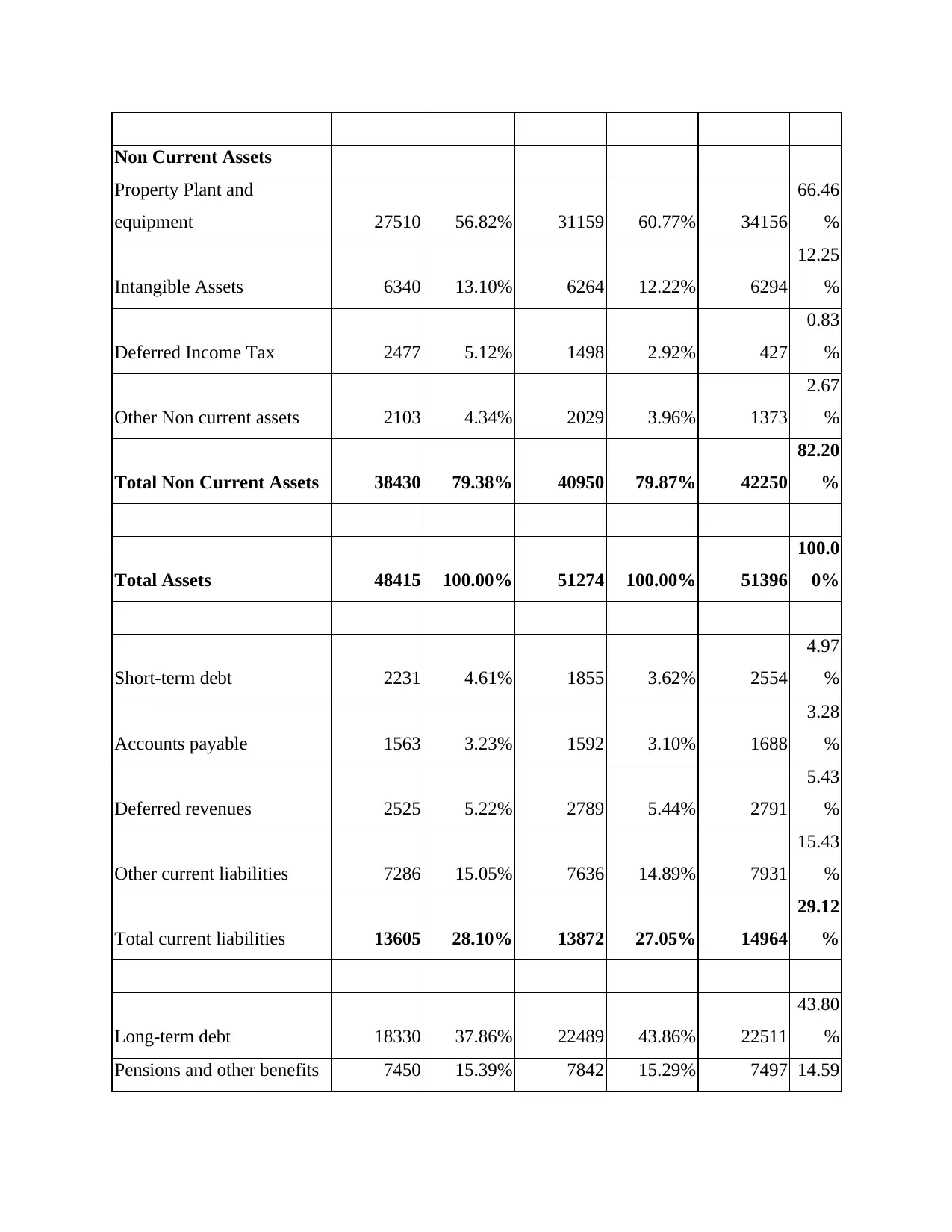
Property Plant and
equipment 27510 56.82% 31159 60.77% 34156
66.46
%
Intangible Assets 6340 13.10% 6264 12.22% 6294
12.25
%
Deferred Income Tax 2477 5.12% 1498 2.92% 427
0.83
%
Other Non current assets 2103 4.34% 2029 3.96% 1373
2.67
%
Total Non Current Assets 38430 79.38% 40950 79.87% 42250
82.20
%
Total Assets 48415 100.00% 51274 100.00% 51396
100.0
0%
Short-term debt 2231 4.61% 1855 3.62% 2554
4.97
%
Accounts payable 1563 3.23% 1592 3.10% 1688
3.28
%
Deferred revenues 2525 5.22% 2789 5.44% 2791
5.43
%
Other current liabilities 7286 15.05% 7636 14.89% 7931
15.43
%
Total current liabilities 13605 28.10% 13872 27.05% 14964
29.12
%
Long-term debt 18330 37.86% 22489 43.86% 22511
43.80
%
Pensions and other benefits 7450 15.39% 7842 15.29% 7497 14.59
Paraphrase This Document
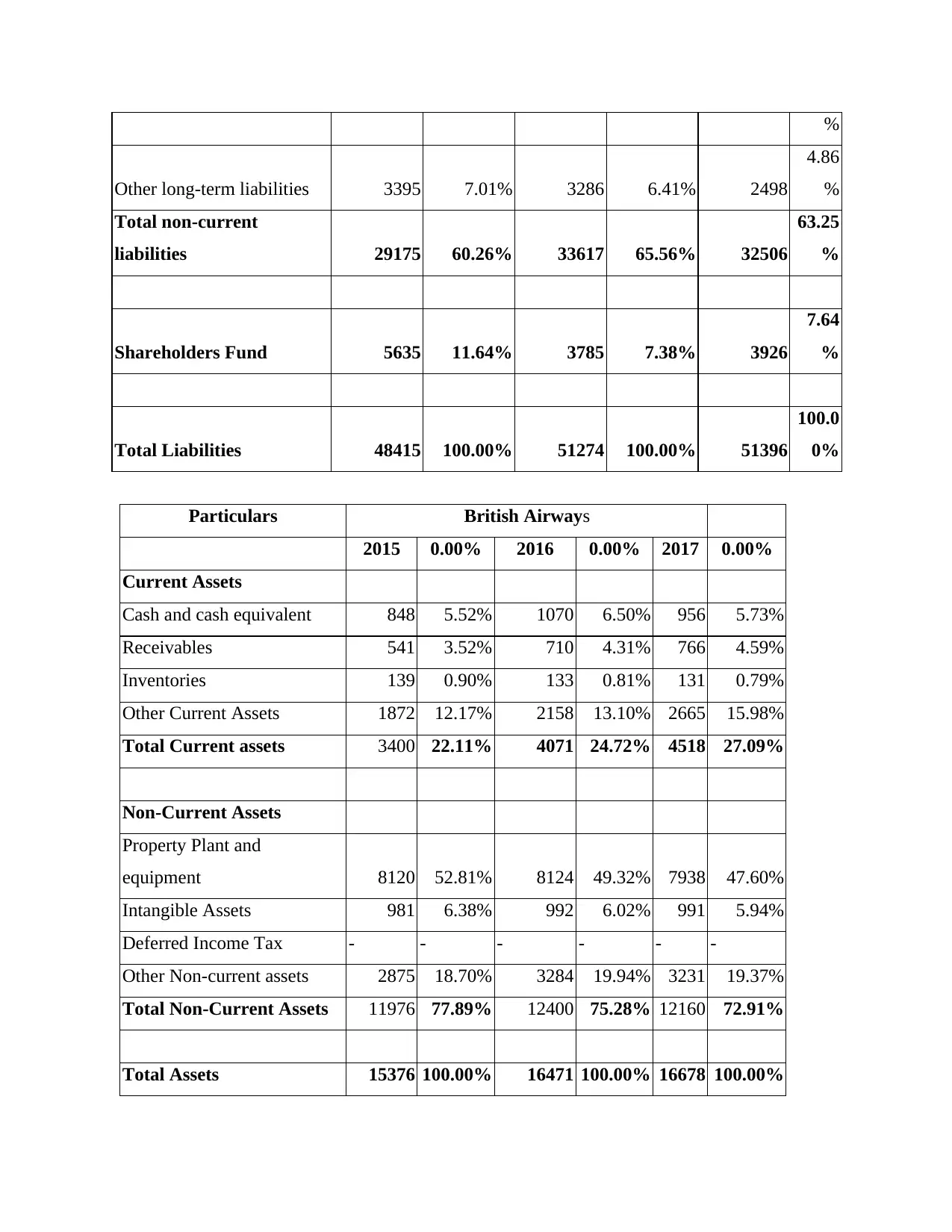
Other long-term liabilities 3395 7.01% 3286 6.41% 2498
4.86
%
Total non-current
liabilities 29175 60.26% 33617 65.56% 32506
63.25
%
Shareholders Fund 5635 11.64% 3785 7.38% 3926
7.64
%
Total Liabilities 48415 100.00% 51274 100.00% 51396
100.0
0%
Particulars British Airways
2015 0.00% 2016 0.00% 2017 0.00%
Current Assets
Cash and cash equivalent 848 5.52% 1070 6.50% 956 5.73%
Receivables 541 3.52% 710 4.31% 766 4.59%
Inventories 139 0.90% 133 0.81% 131 0.79%
Other Current Assets 1872 12.17% 2158 13.10% 2665 15.98%
Total Current assets 3400 22.11% 4071 24.72% 4518 27.09%
Non-Current Assets
Property Plant and
equipment 8120 52.81% 8124 49.32% 7938 47.60%
Intangible Assets 981 6.38% 992 6.02% 991 5.94%
Deferred Income Tax - - - - - -
Other Non-current assets 2875 18.70% 3284 19.94% 3231 19.37%
Total Non-Current Assets 11976 77.89% 12400 75.28% 12160 72.91%
Total Assets 15376 100.00% 16471 100.00% 16678 100.00%
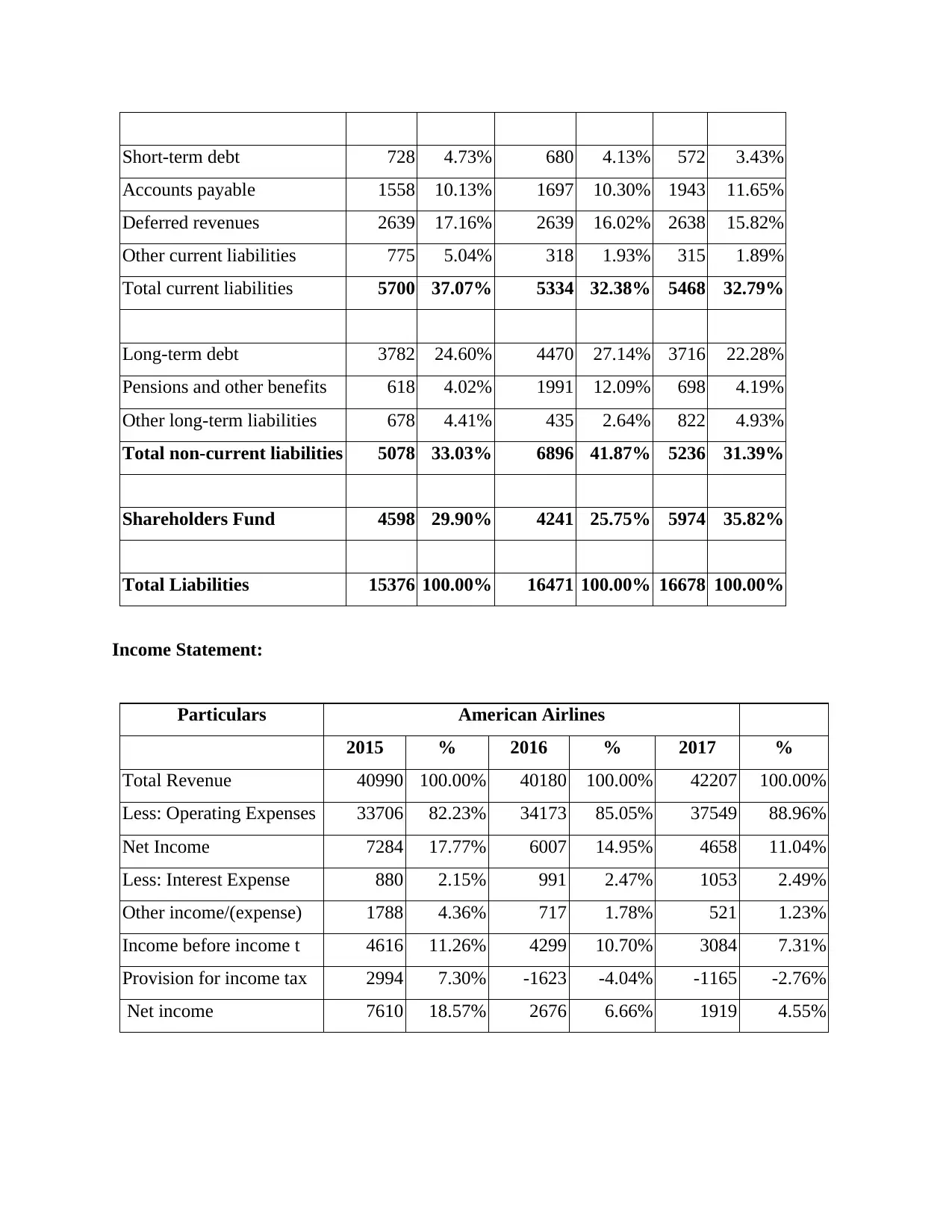
Accounts payable 1558 10.13% 1697 10.30% 1943 11.65%
Deferred revenues 2639 17.16% 2639 16.02% 2638 15.82%
Other current liabilities 775 5.04% 318 1.93% 315 1.89%
Total current liabilities 5700 37.07% 5334 32.38% 5468 32.79%
Long-term debt 3782 24.60% 4470 27.14% 3716 22.28%
Pensions and other benefits 618 4.02% 1991 12.09% 698 4.19%
Other long-term liabilities 678 4.41% 435 2.64% 822 4.93%
Total non-current liabilities 5078 33.03% 6896 41.87% 5236 31.39%
Shareholders Fund 4598 29.90% 4241 25.75% 5974 35.82%
Total Liabilities 15376 100.00% 16471 100.00% 16678 100.00%
Income Statement:
Particulars American Airlines
2015 % 2016 % 2017 %
Total Revenue 40990 100.00% 40180 100.00% 42207 100.00%
Less: Operating Expenses 33706 82.23% 34173 85.05% 37549 88.96%
Net Income 7284 17.77% 6007 14.95% 4658 11.04%
Less: Interest Expense 880 2.15% 991 2.47% 1053 2.49%
Other income/(expense) 1788 4.36% 717 1.78% 521 1.23%
Income before income t 4616 11.26% 4299 10.70% 3084 7.31%
Provision for income tax 2994 7.30% -1623 -4.04% -1165 -2.76%
Net income 7610 18.57% 2676 6.66% 1919 4.55%
⊘ This is a preview!⊘
Do you want full access?
Subscribe today to unlock all pages.

Trusted by 1+ million students worldwide

2015 0 2016 0.00% 2017 0.00%
Total Revenue 11333 100.00% 11398 100.00% 12226 100.00%
Less: Operating Expenses 10094 89.07% 9985 87.60% 10546 86.26%
Net Income 1239 10.93% 1413 12.40% 1680 13.74%
Less: Interest Expense 147 1.30% 145 1.27% 106 0.87%
Other income/(expense) 1536 13.55% 322 2.83% 170 1.39%
Income before income t 2628 23.19% 1590 13.95% 1744 14.26%
Provision for income tax -120 -1.06% -221 -1.94% -297 -2.43%
Net income 2508 22.13% 1369 12.01% 1447 11.84%
HORIZONTAL ANALYSIS:
Balance Sheet:
Particulars American Airlines
2015 2016 % change 2017 % change
Current Assets
Cash and cash equivalent 6254 1.77% 6359 1.68% 5066 -20.33%
Receivables 1425 12.01% 1594 11.86% 1752 9.91%
Inventories 863 26.40% 1094 26.77% 1359 24.22%
Other Current Assets 1443 -8.00% 1277 -11.50% 969 -24.12%
Total Current assets 9985 4.40% 10324 3.40% 9146 -11.41%
Non-Current Assets
Property Plant and equipment 27510 12.98% 31159 13.26% 34156 9.62%
Intangible Assets 6340 -1.25% 6264 -1.20% 6294 0.48%
Deferred Income Tax 2477 -40.00% 1498 -39.52% 427 -71.50%
Other Noncurrent assets 2103 -2.88% 2029 -3.52% 1373 -32.33%
Total Non-Current Assets 38430 7.15% 40950 6.56% 42250 3.17%
Total Assets 48415 3.22% 51274 5.91% 51396 0.24%
Paraphrase This Document
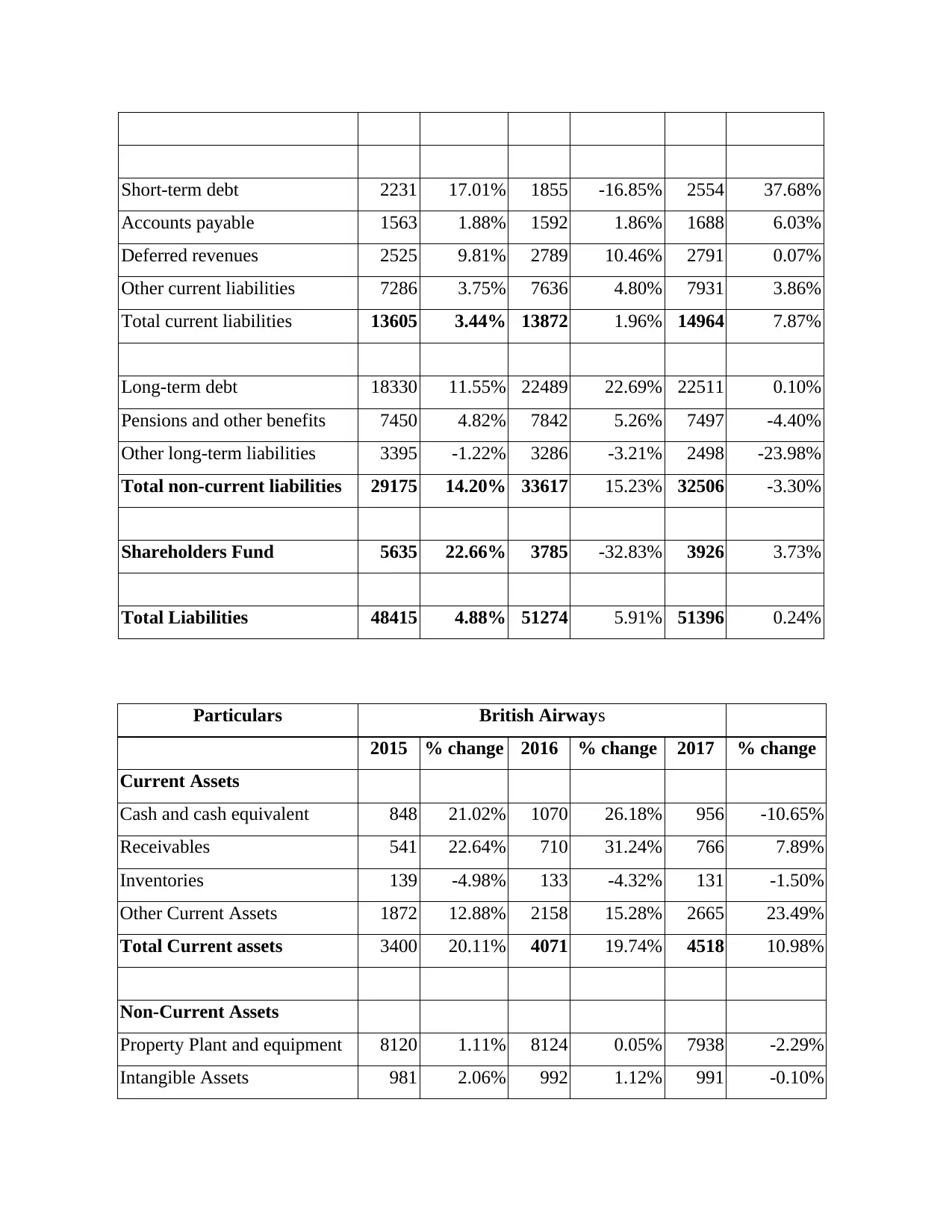
Accounts payable 1563 1.88% 1592 1.86% 1688 6.03%
Deferred revenues 2525 9.81% 2789 10.46% 2791 0.07%
Other current liabilities 7286 3.75% 7636 4.80% 7931 3.86%
Total current liabilities 13605 3.44% 13872 1.96% 14964 7.87%
Long-term debt 18330 11.55% 22489 22.69% 22511 0.10%
Pensions and other benefits 7450 4.82% 7842 5.26% 7497 -4.40%
Other long-term liabilities 3395 -1.22% 3286 -3.21% 2498 -23.98%
Total non-current liabilities 29175 14.20% 33617 15.23% 32506 -3.30%
Shareholders Fund 5635 22.66% 3785 -32.83% 3926 3.73%
Total Liabilities 48415 4.88% 51274 5.91% 51396 0.24%
Particulars British Airways
2015 % change 2016 % change 2017 % change
Current Assets
Cash and cash equivalent 848 21.02% 1070 26.18% 956 -10.65%
Receivables 541 22.64% 710 31.24% 766 7.89%
Inventories 139 -4.98% 133 -4.32% 131 -1.50%
Other Current Assets 1872 12.88% 2158 15.28% 2665 23.49%
Total Current assets 3400 20.11% 4071 19.74% 4518 10.98%
Non-Current Assets
Property Plant and equipment 8120 1.11% 8124 0.05% 7938 -2.29%
Intangible Assets 981 2.06% 992 1.12% 991 -0.10%

Other Noncurrent assets 2875 12.42% 3284 14.23% 3231 -1.61%
Total Non-Current Assets 11976 4.28% 12400 3.54% 12160 -1.94%
Total Assets 15376 5.09% 16471 7.12% 16678 1.26%
Short-term debt 728 -4.98% 680 -6.59% 572 -15.88%
Accounts payable 1558 7.21% 1697 8.92% 1943 14.50%
Deferred revenues 2639 - 2639 - 2638 -0.04%
Other current liabilities 775 5.44% 318 -58.97% 315 -0.94%
Total current liabilities 5700 2.19% 5334 -6.42% 5468 2.51%
Long-term debt 3782 15.22% 4470 18.19% 3716 -16.87%
Pensions and other benefits 618 25.45% 1991 222.17% 698 -64.94%
Other long-term liabilities 678 -11.85% 435 -35.84% 822 88.97%
Total non-current liabilities 5078 25.12% 6896 35.80% 5236 -24.07%
Shareholders Fund 4598 2.55% 4241 -7.76% 5974 40.86%
Total Liabilities 15376 8.65% 16471 7.12% 16678 1.26%
Income Statement:
Particulars American Airlines
2015 2016 2017
Total Revenue 40990 -1.65% 40180 -1.98% 42207 5.04%
Less: Operating Expenses 33706 1.45% 34173 1.39% 37549 9.88%
Net Income 7284 -16.98% 6007 -17.53% 4658 -22.46%
Less: Interest Expense 880 13.00% 991 12.61% 1053 6.26%
Other income/(expense) 1788 -61.00% 717 -59.90% 521 -27.34%
Income before income t 4616 -7.00% 4299 -6.87% 3084 -28.26%
⊘ This is a preview!⊘
Do you want full access?
Subscribe today to unlock all pages.

Trusted by 1+ million students worldwide
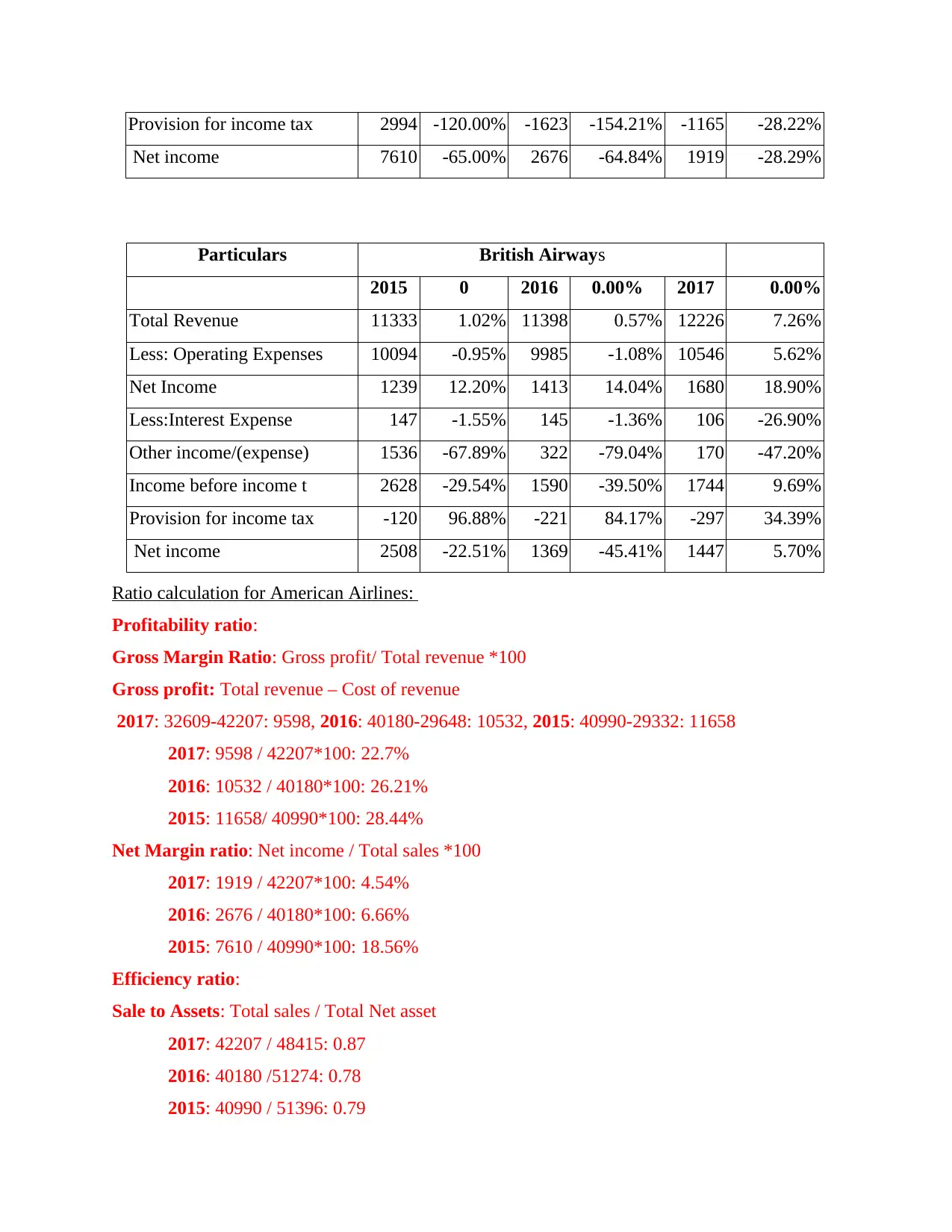
Net income 7610 -65.00% 2676 -64.84% 1919 -28.29%
Particulars British Airways
2015 0 2016 0.00% 2017 0.00%
Total Revenue 11333 1.02% 11398 0.57% 12226 7.26%
Less: Operating Expenses 10094 -0.95% 9985 -1.08% 10546 5.62%
Net Income 1239 12.20% 1413 14.04% 1680 18.90%
Less:Interest Expense 147 -1.55% 145 -1.36% 106 -26.90%
Other income/(expense) 1536 -67.89% 322 -79.04% 170 -47.20%
Income before income t 2628 -29.54% 1590 -39.50% 1744 9.69%
Provision for income tax -120 96.88% -221 84.17% -297 34.39%
Net income 2508 -22.51% 1369 -45.41% 1447 5.70%
Ratio calculation for American Airlines:
Profitability ratio:
Gross Margin Ratio: Gross profit/ Total revenue *100
Gross profit: Total revenue – Cost of revenue
2017: 32609-42207: 9598, 2016: 40180-29648: 10532, 2015: 40990-29332: 11658
2017: 9598 / 42207*100: 22.7%
2016: 10532 / 40180*100: 26.21%
2015: 11658/ 40990*100: 28.44%
Net Margin ratio: Net income / Total sales *100
2017: 1919 / 42207*100: 4.54%
2016: 2676 / 40180*100: 6.66%
2015: 7610 / 40990*100: 18.56%
Efficiency ratio:
Sale to Assets: Total sales / Total Net asset
2017: 42207 / 48415: 0.87
2016: 40180 /51274: 0.78
2015: 40990 / 51396: 0.79
Paraphrase This Document
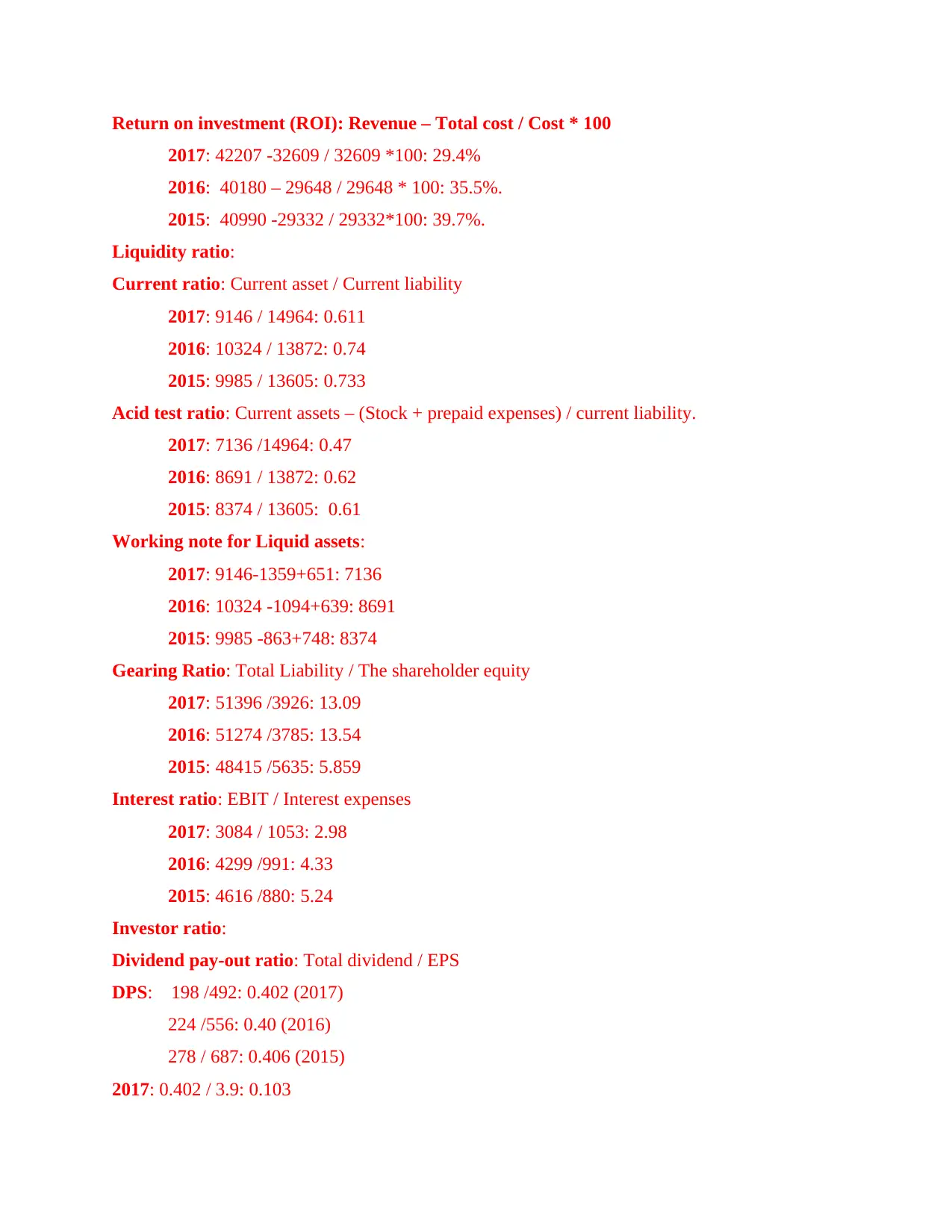
2017: 42207 -32609 / 32609 *100: 29.4%
2016: 40180 – 29648 / 29648 * 100: 35.5%.
2015: 40990 -29332 / 29332*100: 39.7%.
Liquidity ratio:
Current ratio: Current asset / Current liability
2017: 9146 / 14964: 0.611
2016: 10324 / 13872: 0.74
2015: 9985 / 13605: 0.733
Acid test ratio: Current assets – (Stock + prepaid expenses) / current liability.
2017: 7136 /14964: 0.47
2016: 8691 / 13872: 0.62
2015: 8374 / 13605: 0.61
Working note for Liquid assets:
2017: 9146-1359+651: 7136
2016: 10324 -1094+639: 8691
2015: 9985 -863+748: 8374
Gearing Ratio: Total Liability / The shareholder equity
2017: 51396 /3926: 13.09
2016: 51274 /3785: 13.54
2015: 48415 /5635: 5.859
Interest ratio: EBIT / Interest expenses
2017: 3084 / 1053: 2.98
2016: 4299 /991: 4.33
2015: 4616 /880: 5.24
Investor ratio:
Dividend pay-out ratio: Total dividend / EPS
DPS: 198 /492: 0.402 (2017)
224 /556: 0.40 (2016)
278 / 687: 0.406 (2015)
2017: 0.402 / 3.9: 0.103
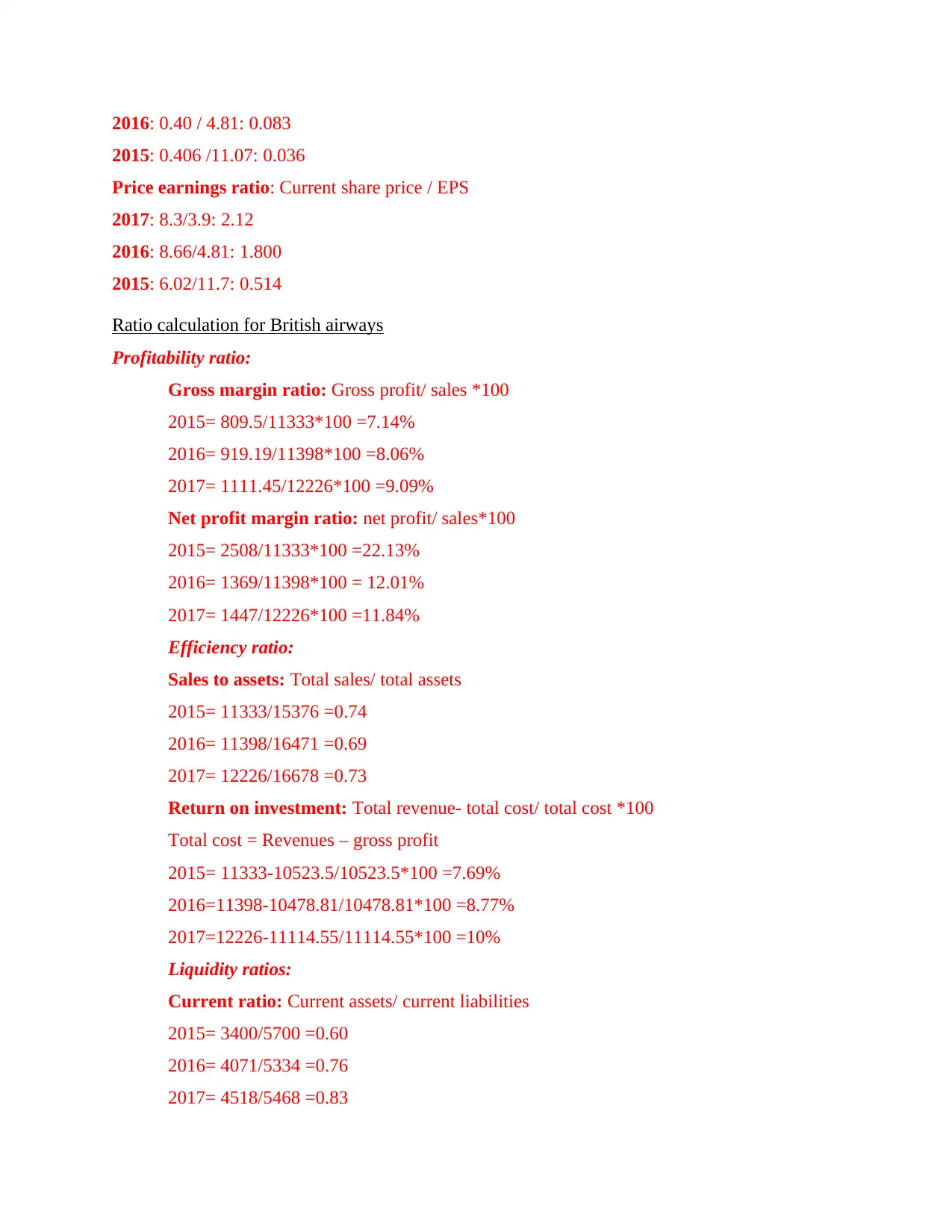
2015: 0.406 /11.07: 0.036
Price earnings ratio: Current share price / EPS
2017: 8.3/3.9: 2.12
2016: 8.66/4.81: 1.800
2015: 6.02/11.7: 0.514
Ratio calculation for British airways
Profitability ratio:
Gross margin ratio: Gross profit/ sales *100
2015= 809.5/11333*100 =7.14%
2016= 919.19/11398*100 =8.06%
2017= 1111.45/12226*100 =9.09%
Net profit margin ratio: net profit/ sales*100
2015= 2508/11333*100 =22.13%
2016= 1369/11398*100 = 12.01%
2017= 1447/12226*100 =11.84%
Efficiency ratio:
Sales to assets: Total sales/ total assets
2015= 11333/15376 =0.74
2016= 11398/16471 =0.69
2017= 12226/16678 =0.73
Return on investment: Total revenue- total cost/ total cost *100
Total cost = Revenues – gross profit
2015= 11333-10523.5/10523.5*100 =7.69%
2016=11398-10478.81/10478.81*100 =8.77%
2017=12226-11114.55/11114.55*100 =10%
Liquidity ratios:
Current ratio: Current assets/ current liabilities
2015= 3400/5700 =0.60
2016= 4071/5334 =0.76
2017= 4518/5468 =0.83
⊘ This is a preview!⊘
Do you want full access?
Subscribe today to unlock all pages.

Trusted by 1+ million students worldwide

2015= 3261/5700 =0.57
2016= 3938/5334 =0.74
2017= 4387/5468 =0.80
Gearing ratios:
Gearing ratio: Total liability/ shareholder's equity
2015= 10778/4598 =2.34
2016= 12230/4241 =2.88
2017= 10704/5974 =1.79
Interest coverage ratio: EBIT/ interest
2015= 1239/147 =8.43
2016= 1413/145 =9.74
2017= 1680/106 =15.85
Investors ratios:
Dividend pay out ratio: Total dividend/ net income
2015= 259/2508 =0.10
2016= 351/1369 =0.26
2017= 460/1447 =0.32
Price earnings ratio: Share price/ EPS
2015= 67/11.07 =6.05
2016= 24.65/4.81 =5.12
2017= 51.25/3.9 =13.14
AMERICAN AIRLINES FINANCIAL RATIOS
2017 2016 2015
PROFITABILITY RATIOS
Revenue 42207 40180 40990
Cost of revenue 32,609 29,648 29,332
Gross Profit 9598 10532 11658
Gross Margin = Gross profit/Sales or revenue 30 33 35
Related Documents
Your All-in-One AI-Powered Toolkit for Academic Success.
+13062052269
info@desklib.com
Available 24*7 on WhatsApp / Email
![[object Object]](/_next/static/media/star-bottom.7253800d.svg)
© 2024 | Zucol Services PVT LTD | All rights reserved.




